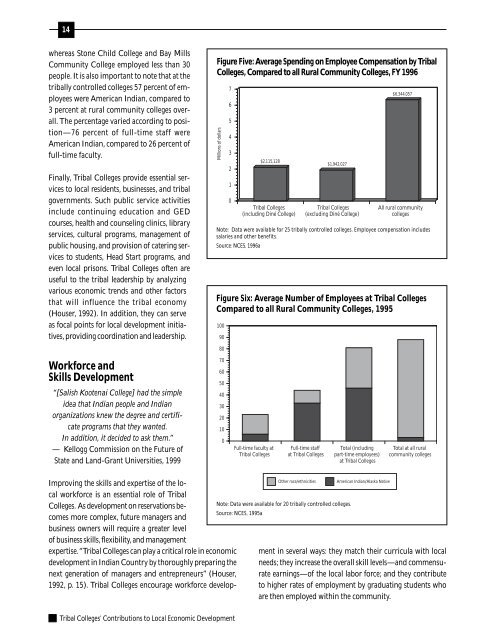14whereas S<strong>to</strong>ne Child <strong>College</strong> and Bay MillsCommunity <strong>College</strong> employed less than 30people. It is also important <strong>to</strong> note that at thetribally controlled colleges 57 percent of employeeswere American Indian, compared <strong>to</strong>3 percent at rural community colleges overall.The percentage varied according <strong>to</strong> position—76percent of full-time staff wereAmerican Indian, compared <strong>to</strong> 26 percent offull-time faculty.Finally, <strong>Tribal</strong> <strong>College</strong>s provide essential services<strong>to</strong> local residents, businesses, and tribalgovernments. Such public service activitiesinclude continuing education and GEDcourses, health and counseling clinics, libraryservices, cultural programs, management ofpublic housing, and provision of catering services<strong>to</strong> students, Head Start programs, andeven local prisons. <strong>Tribal</strong> <strong>College</strong>s often areuseful <strong>to</strong> the tribal leadership by analyzingvarious economic trends and other fac<strong>to</strong>rsthat will influence the tribal economy(Houser, 1992). In addition, they can serveas focal points for local development initiatives,providing coordination and leadership.Figure Five: Average Spending on Employee Compensation by <strong>Tribal</strong><strong>College</strong>s, Compared <strong>to</strong> all Rural Community <strong>College</strong>s, FY 1996Millions of dollars76543210$2,115,128<strong>Tribal</strong> <strong>College</strong>s(including Diné <strong>College</strong>)$1,942,027<strong>Tribal</strong> <strong>College</strong>s(excluding Diné <strong>College</strong>)$6,344,057All rural communitycollegesNote: Data were available for 25 tribally controlled colleges. Employee compensation includessalaries and other benefits.Source: NCES, 1996aFigure Six: Average Number of Employees at <strong>Tribal</strong> <strong>College</strong>sCompared <strong>to</strong> all Rural Community <strong>College</strong>s, 19951009080Workforce andSkills <strong>Development</strong>“[Salish Kootenai <strong>College</strong>] had the simpleidea that Indian people and Indianorganizations knew the degree and certificateprograms that they wanted.In addition, it decided <strong>to</strong> ask them.”— Kellogg Commission on the Future ofState and Land-Grant Universities, 1999706050403020100Full-time faculty at<strong>Tribal</strong> <strong>College</strong>sFull-time staffat <strong>Tribal</strong> <strong>College</strong>sTotal (includingpart-time employees)at <strong>Tribal</strong> <strong>College</strong>sTotal at all ruralcommunity collegesOther race/ethnicitiesNote: Data were available for 20 tribally controlled colleges.Source: NCES, 1995aAmerican Indian/Alaska NativeImproving the skills and expertise of the localworkforce is an essential role of <strong>Tribal</strong><strong>College</strong>s. As development on reservations becomesmore complex, future managers andbusiness owners will require a greater levelof business skills, flexibility, and managementexpertise. “<strong>Tribal</strong> <strong>College</strong>s can play a critical role in economicdevelopment in Indian Country by thoroughly preparing thenext generation of managers and entrepreneurs” (Houser,1992, p. 15). <strong>Tribal</strong> <strong>College</strong>s encourage workforce developmentin several ways: they match their curricula with localneeds; they increase the overall skill levels—and commensurateearnings—of the local labor force; and they contribute<strong>to</strong> higher rates of employment by graduating students whoare then employed within the community.<strong>Tribal</strong> <strong>College</strong>s’ <strong>Contributions</strong> <strong>to</strong> <strong>Local</strong> <strong>Economic</strong> <strong>Development</strong>
15Reservation CasinosThe publicity about prosperous tribal gaming operations is misleading. Media s<strong>to</strong>ries often imply that due <strong>to</strong> thesuccess of Indian casinos all reservation economies are booming and that American Indians are improving theirsocioeconomic standing—neither of which is evident from data on income and poverty (Tootle, 1997). “Contrary<strong>to</strong> popular belief, only a quarter of federally recognized tribes operate casinos, and less than 9 percent earn enough<strong>to</strong> provide direct payments <strong>to</strong> members” (NCSL, 1998). The isolation of many reservation communities makesviable gaming operations impossible, and poverty among American Indians has risen despite the gaming boom(National Committee for Responsive Philanthropy, 1995).Nevertheless, casino gambling has played a major role in the economic growth of some reservations, although notnecessarily on <strong>Tribal</strong> <strong>College</strong> reservations. The greatest concentration of reservation-based casino gambling is inMinnesota, where the relationship between the state and tribal governments is relatively good. 8 Some evidence isavailable that shows positive short-term effects of casino gambling, including increased employment, wage levels,and property values (Levitan and Miller, 1993); small tribes located near major urban areas appear <strong>to</strong> have benefittedthe most (National Committee for Responsive Philanthropy, 1995). Revenue from tribal gambling may be used<strong>to</strong> invest in social welfare programs, tribal operations, economic development initiatives, or other areas (Levitan andMiller, 1993). In fact, tribes have used virtually all their gaming revenue for some aspect of economic development,by channeling it <strong>to</strong>ward tribal employment programs, social and educational programs, and other business enterprises(Leonard, 1996). Some therefore consider gaming operations <strong>to</strong> be a means <strong>to</strong> an end, and many successfultribes are diversifying their economic activities with the profits from gaming. However, the long-term effects ofcasinos remain uncertain, and many fear an increase in crime and other social ills. Other concerns include thesensitivity of gaming revenue <strong>to</strong> economic cycles, and the fact that gambling is a regressive source of revenue—ittends <strong>to</strong> attract more betting by low-income people than by high-income people (Madhusudhan, 1996).Although many of the reservations on which <strong>Tribal</strong> <strong>College</strong>s are located have forms of gambling, only five <strong>Tribal</strong><strong>College</strong>s have received income from gaming revenue from time <strong>to</strong> time (AIHEC, 1997). Those reservations that havecasinos are attempting <strong>to</strong> use the revenue generated from gaming <strong>to</strong> improve the local standard of living and potentiallydiversify in<strong>to</strong> other, more sustainable areas of economic development. In the interim, many <strong>Tribal</strong> <strong>College</strong>s areoffering courses in hospitality and casino management in order <strong>to</strong> train tribal members <strong>to</strong> work in the casinos andparticipate in local <strong>to</strong>urism opportunities. For example, <strong>College</strong> of the Menominee Nation in Keshena, Wisconsinhas offered training in casino management, hospitality, and cus<strong>to</strong>mer service through its National Indian Gamingand Hospitality Institute <strong>to</strong> keep up with the demand for labor on the reservation (D. Wells, 1994).Matching degree programs <strong>to</strong> local needs<strong>Tribal</strong> <strong>College</strong>s offer a range of courses that are specific <strong>to</strong>local communities’ needs. “Program developers have beencareful <strong>to</strong> create programs that produce graduates withhigh employability in local markets” (Hill, 1995, p. 36).Thus, Salish Kootenai <strong>College</strong> first offered courses in forestry,which is a dominant industry in western Montana.Many <strong>Tribal</strong> <strong>College</strong>s offer degrees in such fields as socialservice, secretarial skills, and early childhood education<strong>to</strong> address manpower needs in tribal agencies, day care centers,Head Start programs, and other government sponsoredactivities. In addition, Fort Peck Community <strong>College</strong>in Poplar, Montana and other <strong>Tribal</strong> <strong>College</strong>s have surveyedlocal businesses and community leaders <strong>to</strong> find outwhat skills are needed most. (See Figure Seven.)8The Indian Gaming Regula<strong>to</strong>ry Act of 1988 opened the door <strong>to</strong> legal casino gambling and permits tribes <strong>to</strong> offer any type of gambling on itsreservation that is already allowed by the state for other purposes; casino-style gambling and gambling not legal in the state require compactsbetween tribes and states (Levitan and Miller, 1993).<strong>Tribal</strong> <strong>College</strong>s’ <strong>Contributions</strong> <strong>to</strong> <strong>Local</strong> <strong>Economic</strong> <strong>Development</strong>
















